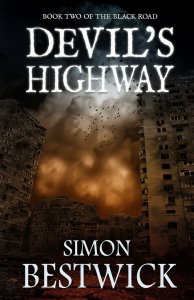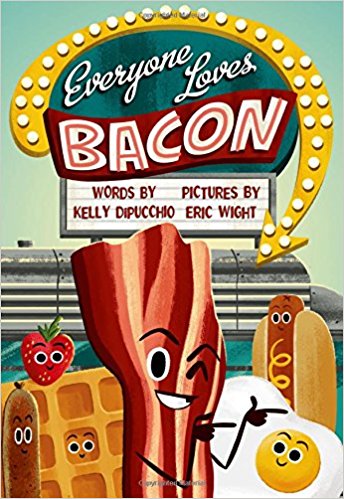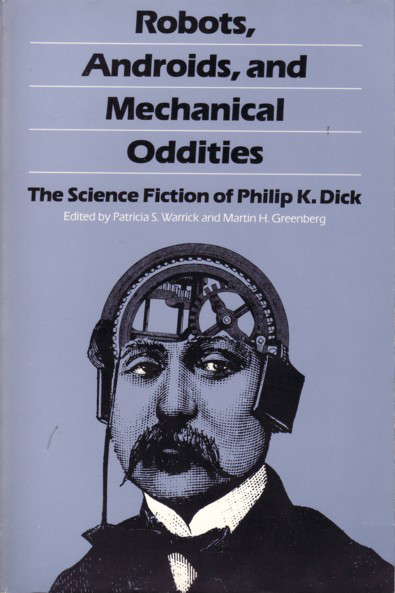Simon Bestwick’s “Hell’s Ditch” – a convincing and exciting vision of post-nuclear Britain – was one of my favourite reads of last year.
I wondered where he would go from there, especially as this is not only the ‘difficult sequel’ but only the second of a four-part series from Snowbooks. It turns out that for this instalment of the Black Road Quartet, he’s decided to whiten everyone’s knuckles with an extraordinary and relentless blast that throws post-apocalypse, violent military thriller and supernatural sf/horror into the cauldron and leaves it all to boil over.
 One of the remarkable things about this novel is that it seems to work as a standalone. It’s almost a year since I read the first book, and wondered if I should dip in and refresh, but there was no need. Of course my memory was jogged by the familiar characters and milieu, but Simon Bestwick ensures that things fall neatly into place on their own. That said, I’d still advise reading “Hell’s Ditch” first because it too is an excellent book (my full review here) and also because it will ensure maximum enjoyment from this. Both you and the author deserve that.
One of the remarkable things about this novel is that it seems to work as a standalone. It’s almost a year since I read the first book, and wondered if I should dip in and refresh, but there was no need. Of course my memory was jogged by the familiar characters and milieu, but Simon Bestwick ensures that things fall neatly into place on their own. That said, I’d still advise reading “Hell’s Ditch” first because it too is an excellent book (my full review here) and also because it will ensure maximum enjoyment from this. Both you and the author deserve that.
But, anyway. Dust has almost settled on the rebel uprising and showdown of the first book. The Reapers, a brutal militia led by Commander Tereus Winterborn, still rule with an iron fist over a beleaguered population, but the rebels have made gains over the harsh winter. Winterborn is attempting to locate their central base – an old fort built into a cliff-side above a system of caves out in the sprawling wasteland -and it’s not just their stronghold he wants. He’s obsessed with bringing the resistance’s poster-girl Helen Damnation to a ghastly end. But at the same time, something is stirring from the ruins at an abandoned base that saw terrifying cosmic experiments, and it becomes clear that guns and knives won’t stop what is being unleashed.
Right from the start of “Devil’s Highway”, we know it’s all about kick off. Like a Mad Max version of the build up to the battle of Helm’s Deep, the author masterfully raises the tension, so it’s a genuinely difficult book to put down before it has even really got going.
After a bloody rebel attack on a Reaper convoy, Winterborn and the psychopathic Colonel Jarrett start closing in on their base. With the help of Dr Kellett, they use a creature of his laboratory tinkering called the Catchman. Sporting glass eyes, claws and a vast, toothsome grin, the Catchman is part mechanical and part flesh: a custom-built hound on the scent. It’s a glorious concept and flawlessly described as the fury of the flesh combines with mechanical calm – the “machine” vs “red brain” – and a far more interesting way to instigate a stalk than an actual hound or simple manhunt. There’s also great attention to detail out in the windswept wastes of the post-nuclear midlands, and I enjoyed the glimpses of rustic life such as the boat people who live in the marshes, unaware of what terrors are moving in their midst.
This hill-climb is made all the more ominous by the Genetic Renewal Division, or “Jennywrens” for short; Winterborn’s merciless extermination squads. They’re chilling enough as individuals or patrols, and readers of “Hell’s Ditch” will be familiar with their barbaric antics, so when a veritable army of them hoves into view on the shattered horizon, the threat is quite exquisite.
After some good old fashioned skulduggery, the tipping point arrives, and from then on the pace and intensity of this novel rarely ebbs until its deeply satisfying conclusion. We are treated to page after page of exploding brickwork, pounding blood, screaming engines, tinkling shells and the rending of flesh, and the action is so clear and succinct – with just the right level of military and technical detail – that it doesn’t outstay its welcome. In fact, it’s never less than addictive. “Hell’s Ditch” was the early stages of the uprising. “Devil’s Highway” is all-out war.
The noise is tempered in the second half of the novel with some very pleasing flashbacks to fill in back story of several characters. These episodes of relative calm allow the reader to catch their breath and gather, but also bring energy of a different kind as humanity, romance, friendship, betrayal and all manner of internal struggles balance the hellish battle that hammers on in the main thread.
Characterisation was a strong point of the first instalment, as it is of any Simon Bestwick tale, and the characters I’d grown to love have all evolved after the long winter since we last met them.
Helen Damnation, the biggest thorn in both Winterborn and Jarret’s sides, is still haunted by her dead family via the phenomenon known as “ghost-lighting”. We learn about her as a teenager during the early days of the Jennywren cleansing and just how vicious they can be. But then so can she. It’s great to read of her formative years and how she ended up with the rebels, and also explains exactly why she’s such a force of nature.
“The things she’s seen and done and felt are old shrapnel: lodged deep, imperfectly healed around, locked where they can’t cause pain except when the wind blows cold”
The last surviving Grendelwolf, Gevaudan Shoal, is back with a flourish. Born of Dr Kellett’s nasty science, almost indestructible and designed to kill, his dry wit, love of music, weary amiability and massive heart are always a pleasure. As are his furious episodes of slaughter on the battlefield. He’s become very close to Helen, which just makes his polar nature more interesting; he’s a ruthless killer and yet such a sweetheart. This is epitomised by a nice moment when he averts his gaze because Helen is changing her clothes while the stains of his last Reaper bloodbath have barely dried on his claws. He’s a very sage man, and although we get a few snippets of his back story, plenty of mystery is maintained. Which is just the way the privately dignified Gevaudan would like it.
Young Danny Morwyn has morphed from nervous newbie to hardened soldier, and Allanah Vale – the resistance veteran who was tortured by Jarrow – is no less damaged, but muscled rather than shrinking, and consumed with the fire of vengeance.
Darrow, Wakefield, Flaps, and the other minor characters are fully fleshed, and we feel for them after only the briefest introduction, such is the author’s talent for investment. Scopes – a near-silent and skinny sharpshooter – is one such character I fell for, despite her lack of speech and relatively short screen time. There’s a poignancy about the younger fighters, all feisty, innocent and afraid. But it’s a different and darker kind of fear for the veterans, because they know the true nature of what’s coming for them.
I really like Zaq, a straight talking and fierce gunsmith who lurks by furnace-light in the fort’s armoury. She scares pretty much everybody, which leads to some splendid and wry dialogue with Gevaudan. The women in this world are just as physically strong and frontline as the men, not because of politics or authorial agenda, but simply because this post-apocalyptic wasteland and its denizens has no concern for gender.
And then there’s the Reapers, of course. Tereus Winterborn – a man who manages to be consumed with rage and utterly calm at the same time – is as vicious, petulant and elegant as ever: all the things an ultra-creepy fascist dictator should be. He still elicits a degree of sympathy, thanks to more fascinating history reveals, and it makes us wonder if he could ever have been anything else? I was riveted by his metamorphosis from child into the monster we see before us now, and we learn why he’s so full of obsessive rage towards Helen. Many of the characters have a nemesis, some of whom are unaware of that fact, and this is put to good use. It’s all about those key moments in life, those forks in the road where people can go either way and be derailed by the subtlest nudge. A strong theme in this book, it shows the enormous influence we have on others whether we realise it or not, and whether we even want – or accept – that responsibility.
Things are never quite black and white with Simon Bestwick, and although there is an undisguised contempt for the Reapers and their vile regime – and rightly so – he doesn’t blame the trapped youths sucked into their ranks to be spat out as cannon fodder. We see the point of view of angry and terrified teenagers such as a young Jennywren called Walters, thrown in at the deep end and under fire of Normandy beach landing proportions. As they cower beneath the onslaught, you really get the miserable horror of being sent to die by the machine. There is also one death scene that I expected to be a satiating revenge kill, which instead turned out to be strangely elegiac. But then, just as the lines between good and evil start to blur, the Jennywrens will beat some children to death with iron bars, and give us a stark reminder of what we were about to pity. I love this toying, and Simon Bestwick is very good at it. Even the amphetamine-popping Jarrow – Allanah’s old torturer – who is some kind of heinous combination of Josef Mengele and Pinhead when it comes to inventive and ice-cold distribution of pain, has her demons and frailties, and worries about coming apart as she’s tormented by her ghost-lighting family.
Nevertheless, we root for the rebels and their inspiring solidarity in battle, so of course there’s heartbreak and heroism, but I found it refreshing that there’s never a moment of dumb gung-ho. The cruelty of war is laid bare, and the ever-wise Gevaudan Shoal sums it up best as he surveys the scene of a massacred Jennywren patrol:
“Next to a battle lost,” he muttered, “the saddest sight is a battle won.”
As I mentioned earlier, there’s a strong Mad Max feel about this book which was absent from “Hell’s Ditch”. Rather than an urban setting, this is the barren wastelands. It’s centred around a heavily armed stronghold, and fills spare moments with high-octane driving and convoy assaults. I loved the action sequences where engine oil joins the arterial spray as pimped-up cruisers flip and shatter in flame, and there’s also a splendid vehicle called the Battletruck that made this Fury Road devotee grin like a War Boy.
The military angle is convincing and much research has clearly been done regarding weaponry and mechanics, aiding the realism and also presenting some raw sniper warfare scenes. With regards to strategy, I like the way it tackles the responsibility of leadership and command, summed up by this powerful thought from someone with a conscience returning to the front line.
“So used to barking orders for others to run and shoot he’d nearly forgotten how it was. Half-scared. Half-glad. At least in that kind of fighting it was simpler; just his life lost if he fucked up.”
The structure is in the form of short chapters, each with a military-esque designation of place, sector, date and time. This is appropriately cinematic, suits the tone of the story to a tee, and is also a neat way of letting us keep track of so many locales and characters as it jumps around.
There’s some exhilarating stalk and kill scenes, and the story gets very tense as it careers into a muscular finale that finally lets the fireworks fizzle out before braining you with pathos. There’s genuine poignancy in this novel, and the intimate relationships that form are brittle. It actually made me tear up, twice towards the end, and not with annoying schmaltz but simple and honest human feelings.
But overall, what an incredible ride this is. The dystopian fire that “Hell’s Ditch” stoked explodes with “Devil’s Highway” using a cast of fully-forged characters to drag us into an epic and imaginative action sequel where nobody touches the brakes, but still makes time to give your heart a good squeeze amid the blood and thunder. It might have been my imagination, but I’m sure my ears were whistling by the end.
The potent conclusion perfectly winds up this part of the story, setting up Book 3 with just the right measure of resolution and anticipation. With the Black Road Quartet now half complete, the bar is set impressively high, but Simon Bestwick gives us no reason to think that the rest of this tour-de-force in progress will be anything less than superb.
Highly recommended.
*Visit the Black Road website here for information on the series, background, character profiles and more.
Like this:Like Loading... Related




